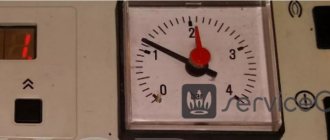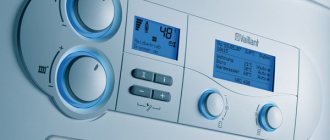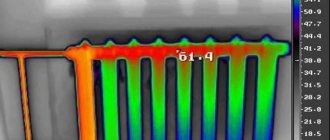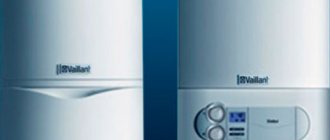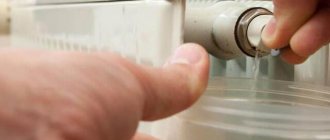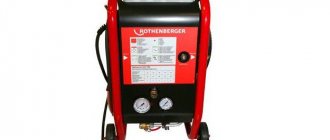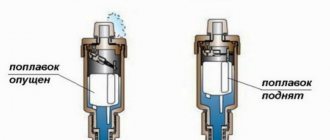Why are air locks dangerous?
The performance of a closed heating system depends entirely on the circulation of the coolant and the supply of a certain amount of heat to the radiators. If air appears in a closed heating system, the normal movement of fluid is disrupted. This phenomenon is considered unpleasant and can cause:
- characteristic noise during water movement. It should be noted that the pipes begin to vibrate, connections weaken, welds are destroyed;
- Air pockets form in the system. Air accumulated in remote areas of the system can disrupt water circulation, and if measures are not taken in a timely manner, the system can be defrosted;
- the efficiency of the heating system decreases, the consumption of fuel resources increases;
- Inside, air enters metal surfaces, contributing to the formation of corrosion.
Air accumulations in the heating system contribute to a shortening of its operational period and premature failure of the equipment.
How does air affect heating performance?
Air in the heating system is one of the reasons for heat transfer disturbances
The operation of a water heating system is based on the circulation of hot water and the transfer of part of the heat to radiators to heat the premises. When air appears in the heating system of a house (this is also called airing), the normal circulation of the coolant is disrupted. The result of this phenomenon is quite unpleasant and can cause:
- noise during water circulation. In addition, this leads to vibration of the pipes and loosening of connections, and in the worst case, causes destruction at the welding points;
- air pockets in the heating system. When they form in separate remote circuits, for example in auxiliary rooms, where the temperature is not monitored in the best possible way and not constantly, this causes a lack of circulation through some batteries, which under certain conditions can lead to defrosting of the entire system;
reduction (sometimes partial) of circulation. When the heating system becomes airy, it causes a decrease in the efficiency of its operation and excessive fuel consumption;
- air entering internal metal parts. This promotes their corrosion. Air in the heating system causes a sharp reduction in its service life, including due to premature equipment failure.
Air in the heating system can lead to pipe leaks
Reasons for the appearance of air in the system
Where and why does air appear in the system if everything is sealed? There is no definite answer, but most often this happens in the following cases:
- the requirements for maintaining the slope of the pipes were violated;
- improper filling of the system with water, resulting in air remaining in the pipes;
- poor connection of components;
- lack of automation that independently removes air from the pipes, or its failure;
- performing repairs during which air definitely enters the pipes;
- filling the system with fresh water, which contains a lot of dissolved air. As soon as the temperature begins to rise, its content in the liquid decreases, and air pockets begin to form;
- the appearance of rust inside the system.
Improper filling of the system with water can cause air to appear
. These reasons cannot cover all possible cases, but with their help you can understand why the system is airy and take timely measures to remove the air lock.
Air removal methods
If you observe on the dashboard that the operating temperature of the engine is constantly exceeded (100 degrees or more), follow a number of steps to identify the problem:
- examine the joints of the pipes, the water pump and the expansion tank for leaks;
- check the fluid level in the tank;
- make sure that the cabin heater is functioning properly;
- If the temperature sensor is installed outside the cylinder head, check the operation of the electric fan by closing the contacts.
Before bleeding the cooling system, it is necessary to eliminate all leaks, if any are found. A water pump seal that has lost its seal should be replaced (as a rule, together with the pump), hose clamps should be tightened, and so on. There is no point in removing an air lock from a leaking cooling system.
Checking the heater and fan sensor will help you more accurately determine the location of the air bubble. When the engine temperature reaches a critical threshold and the heater does not heat up, it means that the plug is in a small circulation circuit - in the stove itself or in the supply pipes. If the sensor does not turn on forced airflow in time, then it has entered an area where the movement of antifreeze has stopped - the bubble is in a large circuit.
Advice. Often, due to an air lock, the thermostat refuses to open the passage of antifreeze in a large circle because it does not “see” the temperature increase. Don't make a common mistake and don't rush to change the thermostat - first try to bleed the cooling system.
Method one - blowing
This simplest method requires caution from the car enthusiast, since it is performed on a fully warmed-up engine. The order of operations is as follows:
- If necessary, add fluid to the minimum level and warm up the power unit to operating temperature. Carefully unscrew the cap of the expansion tank.
- Wear gloves and disconnect the thin coolant pipe at the highest point. For an engine with an injector, this is the throttle valve heating unit; on a carburetor engine, it is the intake manifold or the lower part of the carburetor itself.
- Wipe the reservoir neck thoroughly. Place a wide bowl under the removed hose and blow into the expansion tank. When clean antifreeze flows from the pipe, put it on the fitting and secure it with a clamp.
Attention! On a warm engine, unscrew the expansion tank cap slowly, allowing air to escape. If you remove it abruptly, hot antifreeze will splash out of the neck and burn your hands.
If your vehicle has a thermostatic main radiator cap, try removing the air lock through it. Open both plugs and blow into the neck of the expansion tank.
Method two - complete replacement
This option is suitable for all cases when it is not possible to detect and push a bubble out of pipelines. The point is to completely empty the system and fill it back with antifreeze, following all the rules. The disadvantage of the method is the difficulty of implementation in road conditions.
The procedure is performed in the following order:
- Drain the antifreeze into a wide basin, placing it alternately under the plug on the cylinder block and the main radiator.
- Replace all caps and tighten them.
- Loosen the clamp and remove the throttle body or carburetor heater pipe (the highest point of the system).
- Insert a funnel into the neck of the expansion tank and slowly pour coolant in a thin stream. Air will be removed through the removed hose.
- Monitor the moment when antifreeze runs out of the pipe and immediately put it on the fitting.
Before emptying, be sure to fully open the cabin heater tap.
When the throttle (or carburetor) heating hose is put on and secured with a clamp, add fluid to the container to the required level. Next, check the functionality of the cooling by completely warming up the engine until the thermostat opens and the electric fan turns on.
Method three - road
When faced with overheating of the power unit on the road, try to remove the airlock using this method:
- Having secured the car with the handbrake, lift the front part with a jack to a height of 0.3–0.4 m.
- Slowly unscrew the expansion tank cap, start the engine and turn on the cabin heater to maximum mode.
- Pour antifreeze into the tank in a thin stream until its level reaches the upper limit. Increase the crankshaft speed to 3000 rpm and wait until it warms up completely.
- Squeeze the lower hose leading to the radiator with your hand. The air should escape through the expansion tank. Use gloves or thick cloth to avoid getting burned.
The procedure ends when air stops coming out of the tank. Feel the remaining pipes - they should warm up. Make sure the stove produces a hot stream.
To avoid having to fuss with removing air pockets, always fill in antifreeze according to the instructions described in the previous section. This is the best way to force air out of the system. Fix leaks in a timely manner, do not drive with endless additions of coolant.
Signs of air in the system
The accumulation of air in the heating system and the need to remove the airlock can be determined by the following signs:
- There is noise in the radiators. If the sounds resemble gurgling, then we confidently state the fact that air has appeared in the system;
- Batteries warm up unevenly. If you pay attention to the heat output of the radiator, it will immediately become clear what the main cause of the problem is. In addition to the dirt present inside the battery, an air lock may appear. The pipes remain hot, and the temperature in the radiator decreases slightly;
- A pressure drop can serve as a signal to bleed air in the heating system. In this case, it is necessary to carefully check the pipes for their integrity and the tightness of the joining areas and welds.
The signs given here are quite sufficient to understand that the system should be de-aerated.
How to remove an air lock in the engine cooling system
Before moving on to the process of removing air locks from the cooling system, let's start with the main reasons why they appear.
- First of all, it is worth mentioning depressurization as a result of broken connections of tubes, hoses and pipes. All this leads to the system sucking air through leaks at the joints. Air plugs also form when antifreeze/antifreeze is added.
- It is also worth highlighting malfunctions in the operation of the air valve. As you know, when heated, the antifreeze in the system expands and the pressure increases, but when it cools, the valve is responsible for equalizing the pressure. If the pressure is low, the valve allows air from outside. If there is a problem with this valve, excess air accumulates in the system.
- Sometimes the pump seals stop sealing the system, which leads to air leaks. Also, antifreeze can leak, its volume naturally decreases and excess air accumulates.
So, having dealt with the reasons, let’s move on to the consequences and signs that the cooling system is airy. Let us note right away that the consequences can be quite serious. An air lock can disrupt the circulation of antifreeze, especially if the air does not allow coolant to pass into the radiator. As a result, the motor overheats.
Also, the heater in the cabin begins to work poorly, which reduces comfort when using the vehicle in winter and can pose a threat to the health of the driver and passengers. To solve the problem, you need to know how to remove air from the engine cooling system. At the initial stage, you should make sure that the antifreeze level is normal, and that the cooling system itself is sealed, that is, there are no leaks.
To do this, you need to inspect all rubber parts, hoses, pipes, fittings, etc., and with the engine running. Detection of a leak will require immediate repair. If there are no leaks, but the engine overheats or, conversely, remains cold for a long time, you need to check the thermostat.
It often happens that the device jams in the open or closed position (coolant circulates only in a small or large circle). Less commonly, the reason is that an air lock has formed in the thermostat area.
How to remove an air lock: methods
As mentioned above, the most reliable and common sign of an air lock is cold air from the stove, while the engine is completely warmed up. To get rid of air in the system, there are several available methods (depending on the type of internal combustion engine, the implementation features of its cooling system, etc.).
- You can ventilate the cooling system by removing the pipes through which coolant is supplied to heat the throttle. To do this, remove the plastic cover from the motor, after which free access is opened. Having found the pipes, you need to remove one of them.
Then the cap of the expansion tank is unscrewed, then a clean rag is placed on the neck, then you can blow into the tank. At the same time, do not allow coolant to get into your eyes, onto open skin or inside! Antifreeze and antifreeze are the strongest poison!
The tank should be blown out until antifreeze flows from the removed pipe. Next, the removed tube must be secured in its place, if necessary, add coolant and screw on the tank cap.
- The next method is somewhat simpler than the previous one and is similar to it. First, warm up the engine and then turn off the engine. In this case, there is no need to unscrew the cap of the expansion tank.
It is enough to simply remove one of the pipes on the throttle and wait until coolant flows from there. Next, you need to secure the pipe tightly, tightening it with a clamp. It is important to take into account that the antifreeze/antifreeze leaking from the pipe can be very hot, so you need to be careful not to get burns or injuries.
- The latter method of de-airing the engine cooling system is distinguished by its simplicity and high efficiency.
It is necessary to drive the car uphill so that the “nose” is at the top point. Then you need to tighten the parking brake, you can put wheel chocks under the rear wheels to prevent the car from rolling. We also recommend reading the article on how to perform comprehensive diagnostics of a car’s engine cooling system. From this article you will learn about the main stages of checking the specified system and its individual elements.
Next you will need to unscrew the radiator/expansion tank caps. Then the engine is started and allowed to warm up. During warming up, you need to heavily accelerate it in several approaches, while monitoring the coolant level in the tank and topping it up. This procedure must be continued until the air bubbles disappear. Then all the plugs can be tightened.
Ways to solve the problem
In order to prevent the heating system from becoming airy, it should be properly designed and installed, periodically cleaned and filled with coolant without undue haste. Let's consider the main ways to help avoid such negative manifestations.
Correct installation
In heating systems in which the coolant circulates naturally, with the upper type of wiring, air is removed through the cover of the expansion tank. When installing such a system, the supply line is installed so that it approaches the tank vertically.
The tank, which provides free space for the expansion of the heated coolant, must be installed at the top point of the entire system to ensure the natural flow of liquid into the system circuit.
The return line is also installed with a slope along which the liquid moves freely.
Correct installation will help prevent air from entering the heating system.
If the installation of the heating system is carried out without errors, then the air appearing inside the circuit will be gradually squeezed out by the hot liquid to the top point, leaving the pipes through the open cover of the expansion tank.
Installation of air vents
How to promptly remove air accumulated in the heating system?
An open expansion tank must be installed in the upper part of the heating system, and a hermetically sealed one must be placed in the place where the return flow enters the boiler (before the pipe enters).
In such a system, supply pipes can be mounted without tilting, and the coolant will move under the influence of a circulation pump. In addition, other devices are installed through which air is discharged.
Air can be vented from the heating system itself through special air vents operating in automatic mode, installed on the rotating sections of pipes and at the highest point of the system. The plugs are removed from the radiators using a Mayevsky tap. Using the same principle, air is removed from the circuit through which water circulates naturally, but in this case, lower pipe routing must be done.
If everything is installed correctly, then there will be no problems with how to expel air from the heating system. It is enough to open the necessary taps, and as soon as the air leaves the system, close them again. Air vents operating in automatic mode do not need to be opened at all - their operating principle is based on changes in pressure.
If a closed heating system is installed, an automatic air vent must be installed in it. They are installed along the contour in certain places so that air pockets are removed locally. The idea is that each part of the heating system circuit must have the ability to vent air. An example of this is Mayevsky taps, which are installed on all radiators. Open them with a key or a screwdriver, allowing air to escape from the system. The procedure is quite simple, but with its help you can distribute the coolant evenly throughout the radiator.
An air vent can solve the problem with air in the heating system
To extend the operational life of the automatic air vent, it is necessary to install good filters and regularly flush the system.
Coolant heating
Sometimes, in order to remove excess air naturally, the coolant is simply heated strongly. An increase in temperature stimulates the release of air and its movement along the system circuit. It is allowed to heat the liquid in the pipes up to one hundred degrees.
If after such an operation air pockets appear again, it is necessary to check all connecting areas for leaks. Almost always, near the place where the air jam forms, there is a small gap from which water oozes out in small drops and into which air gradually penetrates. By sealing such a gap, you will immediately get rid of the annoying problem.
Radiators made of aluminum material are considered the most vulnerable places through which air passes. When an alloy is exposed to hot water, corrosion processes develop, accompanied by gas emissions.
If such radiators often become airy, it is recommended to simply replace them.
Airing the heating system. Causes of airing.
One of the most common reasons for the ineffective operation of a heating system is the formation of air pockets in pipelines and heating devices. The presence of air in the system can be determined by touch. Typically, air collects at the high or dead ends of the system, so nearby areas have lower surface temperatures. Blockages and sludge deposits usually occur at low points.
Air enters the system in several ways. Air is dissolved in water, which acts as a coolant. The walls of pipelines made of polymer materials have some oxygen permeability. Also, a certain amount of air may remain in the system after installation or repair work. If certain installation rules and design decisions regarding pipeline slopes and system configuration are not followed, “dead” air-filled bags and zones with minimal coolant flow or complete absence are formed in it.
The presence of air in the heating system can cause various problems. Namely:
1. The movement of the coolant acquires an increased noise level. 2. The efficiency of heating devices decreases. 3. Deterioration of circulation and heat exchange leads to excessive fuel consumption. 4. The impeller of the circulation pump may be damaged. 5. The processes of oxygen corrosion are accelerated.
You can remove air from the system either manually or automatically. Manual (Mayevsky taps) or automatic air vents must be installed on all heating devices.
Manufacturers provide a wide selection of products designed to remove air from the heating system. It is necessary to follow the installation rules, as well as carry out design decisions. A quality project always suggests installing air removal systems at critical points. Automatic air vents are installed in many models of boiler equipment.
Removing air from a central heating system has some difficulties when compared with carrying out the same operation with its autonomous counterpart. The owner of the premises can remove air himself only from heating devices, since he does not have access to the system as a whole. To remove air from centralized systems, you must contact the operating organization.
Preventive measures
We figured out why air appears in the heating system and how to deal with this negative fact. It remains to be seen whether there are preventive measures that help avoid such problems. It turns out yes:
- when installing a heating system, it is necessary to provide for the installation of special devices that automatically remove air;
- Before adding water to the heating system, you should bleed the air;
- During operation, you should monitor the operation of the entire system by observing the readings of pressure gauges and from time to time monitoring the pressure in the pipes. In addition, it is recommended to monitor the level of coolant in the expansion tank, conduct a visual inspection of pipes and radiators, and check the uniformity of heat distribution along the circuit;
- The system should be periodically pumped to remove all blockages.
The implementation of this set of measures will extend the operational period of the entire heating network.


